Underneath the heatsink, the card looks just like the Radeon X1800-series cards, with the exception of the R580 GPU, which is obviously different to the R520 GPU found on the Radeon X1800XL and X1800XT video cards. There is still the same heatsink along the power regulators near the 6-pin PCI-Express power adapter. However, there are some slight differences in the power regulatory system that aren't immediately obvious at a first glance - the Radeon X1900XTX is on the left, while the Radeon X1800XT is on the right. The former features seven Pulse power beads versus six on the X1800.
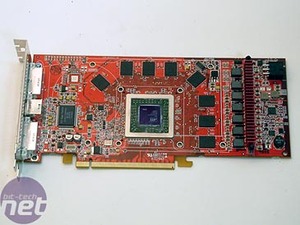
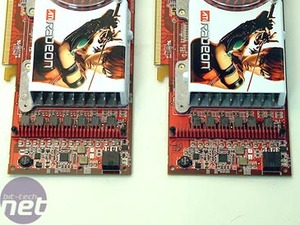 The Radeon X1900XTX video card has a VIVO port powered by the familiar ATI Rage Theater 200 chip. There are also two dual-link DVI ports that are each capable of powering resolutions upto 2560x1600 - this is the resolution used on the new Dell 30" flat screen monitors, along with the Apple 30" cinema display.
The Radeon X1900XTX video card has a VIVO port powered by the familiar ATI Rage Theater 200 chip. There are also two dual-link DVI ports that are each capable of powering resolutions upto 2560x1600 - this is the resolution used on the new Dell 30" flat screen monitors, along with the Apple 30" cinema display.
Instead of the Rage Theater 200 chip, the Radeon X1900 CrossFire Edition video card has the six chips required for the new CrossFire compositing engine. There are two Silicon Image Sil163B TDMS receivers to the left of the shot that run at 165MHz and receive data from the CrossFire ready Radeon X1900-series card via the CrossFire dongle.

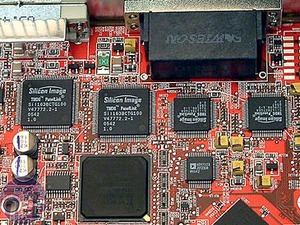 ATI has implemented two of these on the latest incarnation of CrossFire, as a single Sil163B is only capable of displaying resolutions up to 1600x1200 at 60Hz - this was a problem with ATI's intial Radeon X850 CrossFire implementation. However, when the two receivers are combined together, it's possible to pass through enough data to support resolutions of up to 3200x2400. In saying that though, the maximum resolution supported by the dual link DVI ports on the Radeon X1900 series cards is 2560x1600, meaning that this is the maximum possible resolution for these video cards.
ATI has implemented two of these on the latest incarnation of CrossFire, as a single Sil163B is only capable of displaying resolutions up to 1600x1200 at 60Hz - this was a problem with ATI's intial Radeon X850 CrossFire implementation. However, when the two receivers are combined together, it's possible to pass through enough data to support resolutions of up to 3200x2400. In saying that though, the maximum resolution supported by the dual link DVI ports on the Radeon X1900 series cards is 2560x1600, meaning that this is the maximum possible resolution for these video cards.
There are also two smaller Silicon Image chips that are matching TDMS transmitters used to power any displays connected to the X1900 CrossFire Edition card via the DVI output on the dongle. The final chip below the centre-most TDMS transmitter chip is an analogue RAMDAC chip that converts the contents of the video memory into an analogue signal.
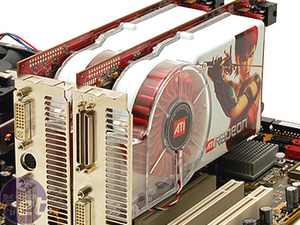
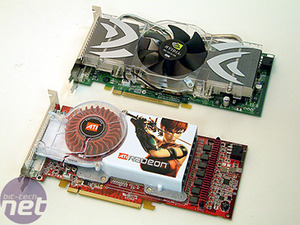 The CrossFire card sits in the bottom slot on the ASUS A8R-MVP - this is the case with most CrossFire motherboards with the exception of DFI's LANParty UT RDX200 CF-DR motherboard. The dongle attachment is not to our liking, as the connections are awkward, fiddly and more prone to breaking. I've personally had a similar sized screw fitting break on my All-In-Wonder Radeon 9600 XT and the slightest bit of carelessness could result in the same happening to the screw fittings on the Radeon X1900 CrossFire Edition card and dongle.
The CrossFire card sits in the bottom slot on the ASUS A8R-MVP - this is the case with most CrossFire motherboards with the exception of DFI's LANParty UT RDX200 CF-DR motherboard. The dongle attachment is not to our liking, as the connections are awkward, fiddly and more prone to breaking. I've personally had a similar sized screw fitting break on my All-In-Wonder Radeon 9600 XT and the slightest bit of carelessness could result in the same happening to the screw fittings on the Radeon X1900 CrossFire Edition card and dongle.
The card is the same length as the NVIDIA GeForce 7800 GTX 512, but the NVIDIA card looks considerably bigger due to the size of the heatsink/fan combination that NVIDIA has chosen to implement. As we mentioned, the Radeon X1900XTX is a little louder than the GTX 512 - the noise differences are even bigger when running two Radeon X1900 cards in CrossFire mode, though. If noise is a concern, it's something worth bearing in mind. Having said that, the fan speed never increased during our CrossFire gameplay evaluations.


Instead of the Rage Theater 200 chip, the Radeon X1900 CrossFire Edition video card has the six chips required for the new CrossFire compositing engine. There are two Silicon Image Sil163B TDMS receivers to the left of the shot that run at 165MHz and receive data from the CrossFire ready Radeon X1900-series card via the CrossFire dongle.


There are also two smaller Silicon Image chips that are matching TDMS transmitters used to power any displays connected to the X1900 CrossFire Edition card via the DVI output on the dongle. The final chip below the centre-most TDMS transmitter chip is an analogue RAMDAC chip that converts the contents of the video memory into an analogue signal.


The card is the same length as the NVIDIA GeForce 7800 GTX 512, but the NVIDIA card looks considerably bigger due to the size of the heatsink/fan combination that NVIDIA has chosen to implement. As we mentioned, the Radeon X1900XTX is a little louder than the GTX 512 - the noise differences are even bigger when running two Radeon X1900 cards in CrossFire mode, though. If noise is a concern, it's something worth bearing in mind. Having said that, the fan speed never increased during our CrossFire gameplay evaluations.

MSI MPG Velox 100R Chassis Review
October 14 2021 | 15:04







Want to comment? Please log in.